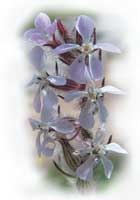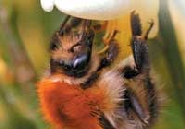Given that 67 per cent of flowering plants rely on animal pollinators for reproduction, it is obvious that increasing pressure from human activities – the introduction of alien plants, habitat fragmentation and agricultural intensification – will seriously compromise this interaction. But little is known about how it works.
All three plants are listed as priority species
The aim of Memmott’s work was to determine which pollinators may be critical for the survival of three rare arable weed species: red hemp-nettle, small-flowered catchfly and spreading hedge-parsley. All three are listed as priority species in the Biodiversity Action Plan. Data on the three plant species, at five field sites, were collected over two years in order to construct visitation and pollen transport ‘webs’. Most interactions between plants and their pollinators are embedded in a complex web of plant–pollinator interactions which, when analysed by software specifically designed for the task, provides a quantitative approach to understanding the pollinator requirements of these rare plant species.
Researching a site involved the sampling of 16 randomly chosen one-metre-square quadrats. On each sampling occasion the floral units per plant were counted and all insects that visited flowers during a 15-minute period were caught. In the laboratory, each insect was first identified and then examined for the type and amount of pollen it carried. From these data it was possible to determine the importance of a particular insect species in pollinating a particular plant species.
It may be possible for rare arable plants to flourish again
The team found that a wide range of insects visited the three plant species and that pollinators varied considerably across their geographical range, but less from one year to the next. Nevertheless, the team was able to identify that the red hemp-nettle was primarily pollinated by the bumblebee Bombus pascuorum at one site and the hover fly Sphaerophoria scripta at another. The latter was also a likely pollinator of the small-flowered catchfly, while the soldier fly, Chloromyia formosa, may be of particular importance in the pollination of the spreading hedge-parsley at certain sites because of its apparent specialisation on the flowers of this species. In addition, all three plants were linked to other plants in the community by shared pollinators. In many cases these other plants constituted the primary food sources for the shared pollinators. Gibson therefore recommends that the management of the rare plants should include the protection and management of populations of some of the more common plant species in their respective communities.
Using this approach allowed the team to identify the probable key pollinators of the three rare plants, and to make recommendations for management of the plant–pollinator communities in which they are found. Unfortunately, the management of arable land for conservation can often conflict with the growing of crops. There is hope, however, with the implementation of new schemes that provide subsidies to farmers for employing environ-mentally beneficial practices such as wide, unsprayed field margins, beetle banks and less intensive hedgerow management. In addition, certain arable plants play an important role in maintaining complexes of beneficial insects, which provide invaluable services to farmers in limiting pest populations. If future agricultural policies are devised with these benefits in mind, it may yet be possible for rare arable plants to flourish in the British countryside once again.

